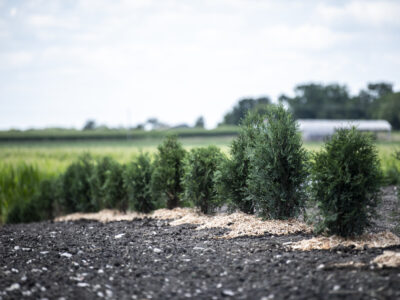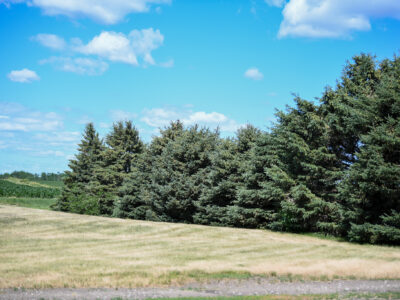The most critical part of any buffer planting is the planning stage. If a problem exists with this foundational aspect the whole project is in jeopardy. For this reason it cannot be stressed too often that guidance be sought during the initial development of your plan.
The situation of every farm will be different. No two will have the same needs or situation, and thus no two farms can have the same vegetative environmenta buffer (VEB) plan. However, there are a few general rules that will help frame the planning process.
To begin, a full assessment of your farm is essential. Some questions which you should consider include:
- What specific purposes must my buffer satisfy? Beyond the generic functions of a VEB, you must tailor your buffer to serve the particular needs of your farm. In other words, are there any special concerns, such as neighbors in close proximity, unique biosecurity risks, or the presence of environmentally sensitive areas nearby, which should be factored into your buffer design? Both existing and potential problems must be accounted for as you plan.
- How are my livestock buildings and/or feedlot oriented on my property? The location of tunnel fans, feed bins, fuel tanks, and the distance from property lines impact the design and flexibility of your buffer plan. The best time to plan a buffer is before any facilities are built. This eliminates the compromises that are required when attempting to fit a VEB onto an existing farm. However, if this is not possible, you must take into account any aspects of orientation that may limit or require adjustment to the design of your buffer.
- What are the prevailing winds? Prevailing winds affect the transmission of odor and dust. These winds are also seasonal in nature and influence heating, cooling and ventilation. In Iowa, winter prevailing winds are primarily from the north and west; summer prevailing winds from the south/southeast. Your design can compensate for wind effect by adjusting row density and varying plant selection. The buffer side most exposed to winter prevailing winds should be planted more densely. Plants should be able to endure the harsh, often strong, winds of winter and capable of forming a reliable windbreak. The side exposed to summer prevailing winds should be planted more loosely to allow air circulation in the summer months. A combination of deciduous trees planted sparsely may provide the best alternative for this area.
- Are there any boundary concerns, company restrictions, or utility issues that might impact or limit my buffer planting? In addition to the obvious limitation of property boundaries, other factors such as county setback requirements, public rights-of-way, or tax ditch rules may impose limitations on where a buffer could be installed. If you work with an integrator, they may have setback requirements for load-out areas, feed bin access, etc. Access to fuel tanks will need to be considered as well. Finally, be sure to allow for any utility lines that may interfere with a buffer planting. Aerial lines impose height restrictions on the plants selected, while buried cable or gas lines must be avoided altogether.
- What are the soil conditions in the planting area? Soil texture, soil history and overall soil quality influence the selection of plants and are critical in determining the overall success of any buffer planting. Most soils around livestock barns and feedlots are often severely disturbed and may contain extremes between wet and dry conditions. Visual observation is often sufficient to assess the general soil condition, but a proper soil test might be advisable to identify the precise condition of soils in the proposed planting area.
- Are there any drainage issues or areas that tend to flood in the projected planting area? Some plants thrive in wet conditions, while others cannot tolerate “wet feet.” You should take into consideration the soil-water relationships that exist on your farm. Areas of poor drainage, with frequent standing water or subject to regular flooding, must be identified and planned accordingly.
- What plans exist for expanding my farm? Since your buffer is a long-term investment, you are well advised to give consideration to future structures which may be built on your farm. It is far better to make allowances for expansion that never comes than to remove previously planted buffer rows to make room for expansion. Likewise, some cost-share programs may impose limits on the removal of buffer plantings during a set time period.
- Are there any existing trees or other features that can be incorporated into my plan? The landscape around your farm may have existing windrows, forested areas, or physical structures that may be incorporated into your buffer plan. Do not be afraid to use them.
- What personal access must be maintained? It may seem obvious, but something as simple as your personal access needs might be overlooked in the planning process. Your buffer should be designed with your personal traffic patterns in mind. Efficient access to home, fields, barns, and other structures should be considered. Allowances for equipment width and movement of field implements may also apply.
Once you have given consideration to these questions, you can turn to the actual design of your buffer. Fundamentally, an effective design should be broken down into two zones. The first zone, in the case of a tunnel ventilated buildings, is the area of direct impact from tunnel fans and adjacent areas affected due to prevailing winds. This is the most critical area for planning since odor and dust loads predominate here. Similarly, the harsh growing conditions caused by these issues, and the drying effect of forced air, make it an area of special attention for plant selection.
The second zone is the area in the buffer planting other than the tunnel fan area. This zone allows greater flexibility in design and plant selection since there are fewer environmental or plant viability concerns. The presence of sidewall fans may require special consideration, but in most cases a simple windbreak is sufficient to address any concerns, while providing an adequate visual screening effect.
Taking into account the character of these two zones, your buffer plan should incorporate some basic standards. These are given as a guide to help frame your plan. Please be aware that various circumstances may require significant adjustment to fit your farm needs, such as the location of neighboring properties, boundary constraints, and prevailing winds. You must plan for the conditions on EACH exposed side of the building or feedlot to be buffered.



